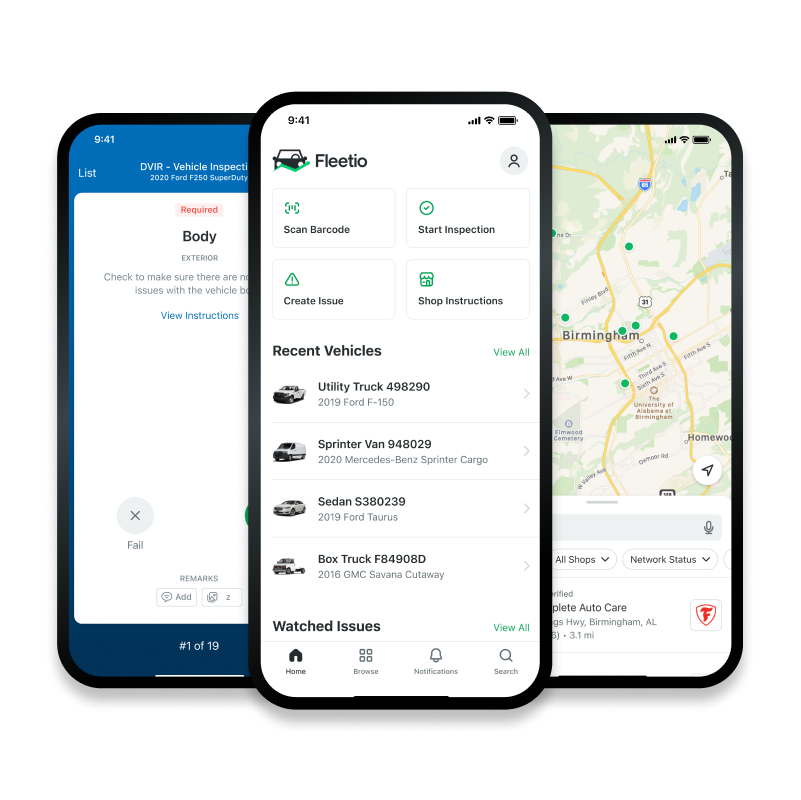Charter Bus Breakdown Tips (Based on Personal Experience)
Charter bus and public transportation fleets often get a level of visibility from the general public that fleets in other industries aren’t as subject to, primarily because their role, first and foremost, is to safely carry people from place to place and prevent breakdowns that could impact timely arrival.
Apr 18, 2024
8 min read

TL;DR: What are the risks of a charter bus breakdown?
Charter bus breakdowns can be high-stakes - with passengers on board, safety, communication, and calm decision-making are critical to managing the situation well.
Why breakdown preparation matters for bus fleets
- Passenger safety and perception are top priorities
- Delayed or mismanaged incidents can damage your reputation
- Preventive maintenance and clear protocols reduce risk and downtime
Top tips for handling a bus breakdown
- Prioritize safety by pulling over securely and addressing any immediate risks
- Keep passengers informed with clear, calm updates via group leaders or chaperones
- Call dispatch right away to report the issue and request assistance
- Assess the problem carefully and troubleshoot only when it’s safe to do so
- Stay professional and composed to help passengers remain calm
A well-prepared driver and strong fleet protocols make breakdowns manageable - and help keep riders safe, informed, and confident in your service.
Throughout my time at Fleetio, I’m struck by the increasingly tangible touch points where my life intersects with fleet management, always in ways I never noticed before spending the majority of my days knee-deep in reading and writing about the industry.
One of those touch points came for me as I chaperoned a high school field trip to Disney World, when somewhere outside of Tallahassee, the back half of our charter bus started to get woozy from exhaust fumes being pumped right into the cabin from a bent tailpipe. The driver had accidentally backed over a curb as we were leaving our lunch stop an hour before, and since we were already experiencing some delays in our trip, decided to hastily hit the road without investigating further.
We eventually persuaded the already frustrated driver to pull off at a rest stop after some of the asthmatic kids’ raised concerns about their breathing and we felt (and heard) the bus rattling, and one of the other chaperones, an auto technician who was good with a crowbar, found the problem and was able to jimmy the exhaust pipe back to its original position, a Band-Aid fix just to get us home.
But the only thing I could think about the whole time was, “How much better could this situation have gone if there had been more attention paid to safety protocol?”
There’s a higher level of scrutiny on those fleets to ensure that processes and procedures are consistently enforced by bus fleet management, and then strictly adhered to by drivers. When your customers are literally on board, it’s hard to hide any lapses that may occur.
As we sat at that rest stop outside of Tallahassee administering albuterol and trying not to get rained on, there were a handful of things that I considered as I wondered what could have been done to prevent the situation we were in, from both my perspective as an informed fleet writer and a concerned passenger. Here are a few of the tips I came up with for charter bus management and drivers handling breakdowns and emergencies.
10 tips for handling charter bus breakdowns
1. Safety First
The safety of passengers and other drivers on the road should always be the top priority, but especially the passengers – even if that sense of safety is entirely mental. If passengers begin to raise concerns about the operational safety of the bus, err on the side of caution and make a stop, either immediately if the concern is pressing or on your next scheduled stop if it’s not. When you do stop, ensure that the bus is safely pulled over to the side of the road and turn on hazard lights to alert other drivers, or take a safe exit to a travel center or well-lit rest stop.
Pro Tip
The best way to prioritize safety? Consistent charter bus maintenance. Drivers should be sure to prioritize thorough inspections so any issues can be addressed before they crop up on the road, and charter bus fleet managers should keep an optimized PM schedule for all of their assets to maximize their uptime.
2. Communicate with Passengers
Keep key passengers like group leaders, teachers and chaperones informed about the situation and reassure them that their safety is being prioritized. Answer their questions to the best of your ability, but be willing to say if you are unsure at the moment and seek assistance from your dispatch or management. Provide clear instructions on what passengers should do to leaders, such as remaining seated or exiting the bus if necessary, and once they understand, allow them to communicate that to their group for ease of understanding.
⠀
3. Contact Dispatch or Company Immediately
Notify your company's dispatch or control center immediately to report the bus breakdown and seek assistance. Provide as much specific information as you can, including location and mile markers, the nature of the problem and any relevant information about the condition of the bus and passengers.
Pro Tip
Keeping quiet about issues that happen on the road benefits no one – an issue that may seem small and immediately repairable in the short term can add up to serious costs in time, maintenance and goodwill in the future!
4. Follow Emergency Procedures
If you discover that the breakdown poses a significant safety risk, follow established emergency procedures as outlined by your company. This may include evacuating passengers to a safe location away from the bus, which is why it’s important to choose your location wisely when you pull off the road.
⠀
5. Assess the Situation
After conducting a thorough inspection, evaluate the extent of the breakdown and decide if it can be resolved on the spot or if you’ll need professional assistance. Attempt basic troubleshooting if safe to do so for things like blown fuses or low fluid levels, but never be afraid to call in an expert opinion, even if it means a longer wait. ⠀
The fleet management platform transportation companies trust
Fleetio is designed with transportation companies in mind, allowing you to closely track your inspections and maintenance as well as integrate with your GPS and telematics partners.
Learn more6. Stay Calm and Professional
It’s of utmost importance to maintain a professional demeanor when interacting with passengers and handling the situation. If you freak out, they’re going to freak out. Simply remaining calm can help alleviate anxiety and reassure passengers that the situation is under control. If a passenger becomes agitated or combative, find another member of the party to mediate and separate yourself from the situation so you can focus on the task at hand. Cooler heads will always prevail, and the thing that matters most for maintaining a positive relationship with a customer during breakdown response is a calm approach and expedient solution.
⠀
7. Provide Comfort and Assistance
There’s a chance that the issue at hand may create difficulties for some of your passengers, depending on their age, health status or even the environment they’re in, such as being exposed to severe weather or extreme temperatures while pulled over. Help facilitate assistance to passengers who need it, like allowing them access to luggage to retrieve medications or leaving on temperature controls when possible if they’re still seated in the vehicle. Be sure to provide updates on the progress of repairs to passengers and work with your dispatcher to offer alternatives if there will be a significant delay.
Pro Tip
If you’re able, pulling off at a rest stop or travel center when you’re able gives passengers access to food, air conditioning/heat, bathrooms and shelter while you diagnose a problem. Allow them to leave the bus and delegate group management to leaders and chaperones so you can focus on the task at hand.
8. Follow Company Protocols
It’s vital that you adhere to the protocols and procedures outlined by your company for handling breakdowns. This may include contacting a specific list of approved roadside assistance providers or following specific steps for documenting the incident.
⠀
9. Stay Prepared
Medical issues can arise at any time, so ensure that the bus is equipped with emergency supplies such as first aid kits. You’ll also want to double check in your pre-trip inspections that your vehicle is supplied with reflective vests and warning triangles if you’re forced to address an issue on the shoulder of the road. Familiarize yourself with the location of all safety items and know how to use them in case of an emergency.
⠀
10. Document the Incident
Keep thorough records of the breakdown, including the time, location, nature of the problem, actions taken, and any communications with the company or authorities. If you use a fleet maintenance system, be sure to follow your company’s process for reporting issues in the platform with detailed documentation and photos. This information may be useful for reporting purposes or for future reference.
Manage emergencies efficiently with Fleetio
Communicate effortlessly when issues arise with a mobile fleet management platform that houses all of the information you need to resolve breakdowns quickly.
Get a free demo
Senior Fleet Content Specialist
As a Senior Fleet Content Specialist at Fleetio, Peyton explores the voices and experiences that shape fleet operations. She focuses on how fleet professionals adopt technology, improve efficiency and lead their teams to bring clarity and context to the challenges happening across the industry.
View articles by Peyton PanikReady to get started?
Join thousands of satisfied customers using Fleetio
Questions? Call us at 1-800-975-5304

